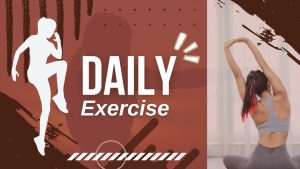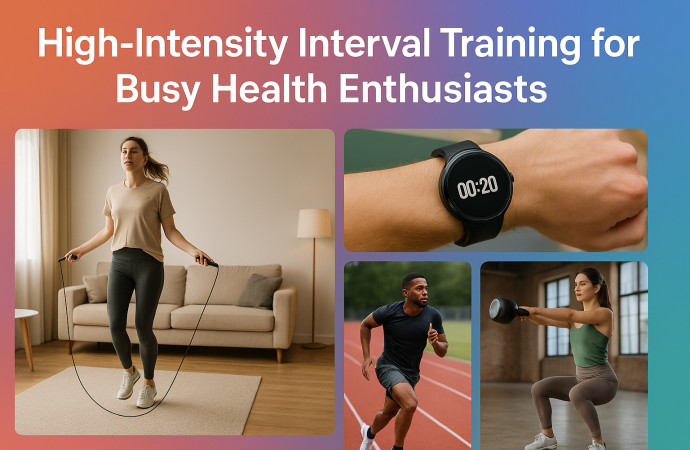Introduction Time is the modern excuse for skipping workouts, yet research keeps proving that you do not need an hour to stay fit. High‑Intensity Interval Training (HIIT) replaces long cardio sessions with short bursts of maximum effort, followed by brief rest. In as little as fifteen minutes, you can trigger calorie burn that lasts for
Introduction
Time is the modern excuse for skipping workouts, yet research keeps proving that you do not need an hour to stay fit. High‑Intensity Interval Training (HIIT) replaces long cardio sessions with short bursts of maximum effort, followed by brief rest. In as little as fifteen minutes, you can trigger calorie burn that lasts for hours after you stop moving. This guide explains HIIT from the ground up and shows busy health enthusiasts how to slot powerful sessions into lunch breaks, commute gaps, or family schedules without expensive gear or gym fees.
What Is High‑Intensity Interval Training?
High Intensity exercise pairs short periods of near‑maximal effort—think sprinting, jumping rope, or cycling at top speed—with equal or slightly longer rest intervals. A classic structure uses a 1:1 ratio, such as thirty seconds of hard work followed by thirty seconds of slow recovery. You repeat these cycles eight to twelve times. Because intensity stays high, total workout time remains short while producing cardiovascular and metabolic benefits similar to longer moderate‑pace exercise.
How HIIT Differs from Steady‑State Cardio
Steady‑state cardio keeps heart rate moderate for twenty to sixty minutes. HIIT spikes heart rate above eighty‑five percent of maximum, then lets it drop before the next burst. This roller‑coaster pushes the body to adapt quickly, improving oxygen use and insulin sensitivity in fewer sessions per week.
Science‑Backed Benefits for Busy Schedules
Researchers report that three HIIT sessions per week, each under twenty minutes, can raise VO₂ max—your body’s top oxygen‑using ability—by up to fifteen percent in eight weeks. That means more energy for both workouts and daily tasks. HIIT also elevates excess post‑exercise oxygen consumption, or EPOC, burning calories for up to twenty‑four hours after you finish.
Short workouts help adherence because they slot easily between meetings. A study in the Journal of Sports Medicine found adherence rates climb when routines stay under fifteen minutes, proving that time saving alone keeps people consistent.
Building Your HIIT Routine

Image by: Yandex.com
Step 1: Pick Movements
Choose full‑body exercises that raise heart rate quickly. Options include burpees, mountain climbers, squat jumps, or cycling sprints. Beginners can start with brisk stair climbs or fast walking to keep joints safe.
Step 2: Set Work‑Rest Ratios
For newcomers, twenty seconds of effort and forty seconds of rest (1:2) ease the body into intensity. Intermediate athletes move to the classic thirty‑second 1:1 pattern. Advanced users may try Tabata: twenty seconds on, ten seconds off, repeated eight times for four minutes total.
Step 3: Define Session Length
Ten minutes works on rush days; fifteen to twenty minutes covers warm‑up and cool‑down on regular days. Remember, longer is not better if intensity drops. Maintain quality over quantity.
Step 4: Warm Up and Cool Down
Five dynamic warm‑up minutes—arm circles, leg swings, light jogging—prime muscles and reduce injury risk. Finish with gentle stretching to lower heart rate and ease soreness.
Table – Sample 15‑Minute HIIT Session for All Levels
| Round | Movement | Work Time | Rest Time | Low‑Impact Swap |
|---|---|---|---|---|
| 1 | Burpees | 00:30 | 00:30 | Step‑back burpees |
| 2 | Jump Squats | 00:30 | 00:30 | Bodyweight squats |
| 3 | High‑Knee Run | 00:30 | 00:30 | March in place |
| 4 | Mountain Climbers | 00:30 | 00:30 | Elevated climbers |
| 5 | Push‑up Jacks | 00:30 | 00:30 | Knee push‑ups |
| 6 | Skater Hops | 00:30 | 00:30 | Side steps |
| 7 | Plank Jacks | 00:30 | 00:30 | Static plank |
| 8 | Sprint in Place | 00:30 | 00:30 | Fast walk |
Repeat rounds if time allows; always finish with a cool‑down.
Safety First: Listening to Your Body

Image by: Yandex.com
HIIT stresses heart and joints, so check with a health professional if you have cardiac or orthopedic issues. Start slowly; rate sessions on a scale of one to ten. Stay around seven for most bursts, edging to nine only when form stays solid. Pain, dizziness, or sharp joint twinges signal an immediate stop and rest day.
Nutrition for High‑Intensity Success
Fuel matters. Eat a balanced snack—banana with nut butter or Greek yogurt with berries—about sixty minutes before training. This mix of carbohydrates and protein maintains energy without bloating. Post‑workout, replenish with lean protein and complex carbs within ninety minutes to aid muscle repair and glycogen recovery. Hydrate well; even two‑percent dehydration lowers performance.
Tracking Progress in Limited Time
Busy schedules demand quick feedback. Use a fitness watch or phone app that logs intervals, heart rate, and recovery time. Note personal bests, such as maximum push‑ups in thirty seconds. Re‑test every four weeks to see improvements without extended testing sessions. Non‑tech signals work too—if stairs feel easier or jeans fit looser, progress is clear.
Common Mistakes and How to Avoid Them
Skipping warm‑ups: Cold muscles strain easily. Five minutes of prep saves weeks of recovery.
Going all‑out every day: Muscles grow and adapt during rest. Schedule at least forty‑eight hours between intense sessions.
Ignoring form: Sloppy technique under fatigue invites injury. Slow down rather than bend knees incorrectly or arch the back.
Monotony: Same moves overload specific muscles. Rotate exercises every two weeks to target new fibers and keep motivation high.
Integrating HIIT into a Packed Week

Image by: Yandex.com
- Morning kick‑start: Ten‑minute session right after waking boosts metabolism and mental alertness.
- Lunch‑break blast: Use park benches or office stairs for a fifteen‑minute cycle; return to work refreshed.
- Commute split: Bike or brisk walk to a safe spot, add four Tabata rounds, then continue home.
- Weekend combo: Pair HIIT with family fun—race kids for intervals, then walk during rests.
Consistency wins over occasional marathons. Three short sessions beat one long one that never fits.
HIIT and Mental Well‑Being
Fast, intense exercise spikes endorphins and reduces cortisol, easing stress built up during hectic days. Studies show that subjects completing twelve‑minute HIIT feel the same mood lift as those performing thirty minutes of steady cardio. Because sessions end quickly, guilt from skipped workouts drops, supporting long‑term mental health.
Advanced Tips for Seasoned Enthusiasts
- Add light dumbbells or resistance bands to standard moves for extra load.
- Use “ladder” intervals—work time lengthens each round while rest stays fixed—to push endurance.
- Mix cardio and strength training: sprint then perform kettlebell swings for full metabolic challenge.
Monitor resting heart rate each morning. A sudden rise often signals overtraining; dial back intensity that day.
Conclusion
High‑Intensity Interval Training turns the “no time” barrier into a myth. By cycling all‑out effort with brief rest, you unlock fat loss, cardio gains, and mental clarity in sessions shorter than a coffee break. Match exercises to fitness level, fuel smartly, respect recovery, and track small wins. With HIIT, even the busiest schedule can hide room for powerful health upgrades.
Take the Next Step
Set your timer for ten minutes, choose three favorite moves, and test your first HIIT circuit today. Share your results with friends or social media to stay accountable, and watch quick workouts become a lifelong habit.
















